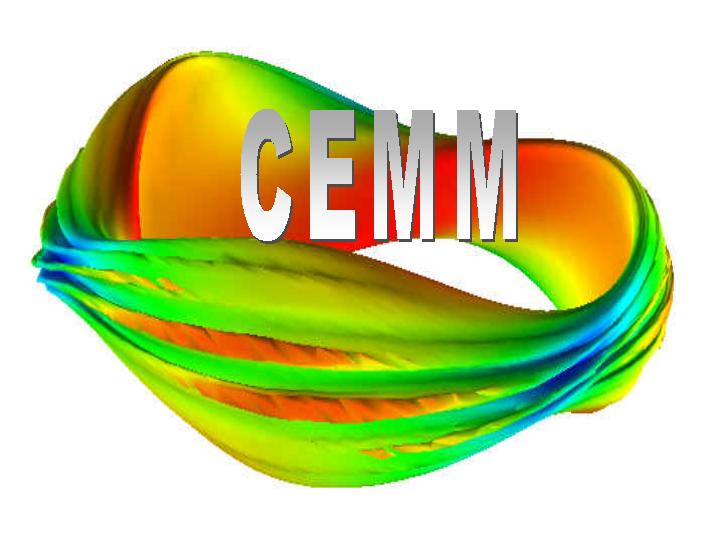

Testproblems
A=10, a=0.1, R=1.0, zero beta, circular, q = 1.1 + 1.8 s**2, (From Harley, Cheng, and Jardin, J.Comput.Phys 103 43 (1992)
Liu's results with MARS for 1A and 1B ps or pdf
(1 Sept 2000)The MARS code utilized extreme grid backing around the rational surfaces. Both 128 and 256 radial resolution was used with 7 poloidal harmonics. The code gave a good fit to the scaling: gamma = C S**(-3/5) for a range of S from 10**4 to 10**8. For S=10**6, it converged using 2 different methods to a value of gamma = 2.2 x 10-4. This is to be compared with the NIMROD result of gamma*tau_A = 1.6 x 10-6 (3.3 x 10-5) for S=1.2 x 10**5 for a Prantle number of 1 (0.1)
(Oct 22 2000) Gianakon reports the Near and MARS codes agree. A scan has been done with NIMROD from S=10**4 - 10**8, Pr=10**(-2) - 10**0. Agreement is to about 6%. Nonlinear simulations with S=1.2 E5 and Pr = 1.e-2 have begun.
(Oct 22 2000) X.Tang reports that with grid packing, and S=1.5e4, Pr = 10**(-2), parM3D is getting about the right order of magnitude, but is not yet converged.
(April 3 2001) X.Tang reports with S=10**4, parM3D growth rate 5 times smaller than the MARS value
DIII-D (Provided by Ming Chu)
R=1,7, a=.65, kappa=1,8, delta=0.3
ff' = constant*(1.3 - 1.6* s + 0.3 s**2)
q_0 = 1.2 (unstable to tearing for q_0 from 1.05 to 1.5)
(1 Sept 2000) The MARS code was used with 128 and 256 finite elements and 30 poloidal harmonics. For S=10**8, it converged to a value of gamma = 2.46 x 10**-5. For comparison to NIMROD, for S=10**6 and with the resistive normalization, MARS obtained a value gamma*tau_R = 3.688 x 10**2 to be compared with NIMRODs value of 3.4 x 10**2. The discrepency could be due to the viscosity in NIMROD.
(Oct 22 2000) NIMROD is packing around 2 surfaces and using high-order elements. They obtained a scaling with Pr for S=10**4 and S=10**6.
(Nov 14 2000) NIMROD and MARS show good agreement in linear phase for S=10**4 - 10**6, Pr = 10**-1 - 10**-4. Nonlinear run has started with S=10**4, Pr=10**-1, n=0,1,2. 20,000 time steps each of 1/2 global Alfven time. Takes 10/sec/time step with 18 processors.
(Nov 14 2000) Strauss reports some results for single Fourier version of the M3D. He gets gamma = .0012 for eta=e-5, mu=E-7.
(April 3 2001) X.Tang running with S=10**4, finds growth rate too small
2-fluid physics: Tokamak in a periodic cylinger with S=3.09 e4, A=10, m=1 mode. Comparison with semi-analytic Zakharov-Rodgers result.
(April 4 2001) Nebel reports NIMROD is running with the Hall parameter .014 and the growth rate from NIMROD is greater than from M3D. This may not be an exact comparison since the gyroviscous terms are in M3D but not in NIMROD.
Kinetic MHD : case presented by Gorelenkov at Budapest EPS
R=2.62 m, a=0.95 m, beta_0 = 5%, B = 4.45T
Ideal MHD: Zero-hot-particle-test-case with R/a 2.763, peak beta 8%, q0=0.6
(April 3 2001)X.Tang reports parM3D Ideal growth rate computed vs viscosity. Used S=10**5 and S=10**7 to extrapolate into the ideal case. Nonlinear run has a problem because the reconnection flux exceeds the wall radius.
(April 4 2001) G.Fu reports double fourier version of M3D agrees with NOVA, with a growth rate of 0.026 in units of V_A/R0, where R0=2.763 and V_A is defined with the vacuum BT at the geometric center. The specific heat coefficient used is 1.6667.
(6 Sept 2001) Carl Sovinec reports: I think we now have agreement between the different codes on the ideal kink benchmark. Recall from the last CEMM meeting that the growth rate I reported was considerably higher (~40%) than the MARS result. At first, I thought we may have had the wrong equilibrium or a normalization problem. Guoyong checked the equilibrium, and the parameters were correct, and I did not find a normalization, i.e. tau_A definition, error. I ran more cases checking resolution and other parameters, but nothing changed.
Becoming suspicious of the equilibrium, I asked Ming Chu to try the case with GATO. He helped in two ways. In addition to running the case, he was unable to use the Chease equilibrium, so he generated it with TOQ. Looking at F(psi), q(psi), and p(psi), the profiles appear very similar to the Chease profiles. However, running nimrod with the TOQ equilibria produces smaller growth rates. My converged result with the TOQ equilibrium is:
gamma*tau_A_GATO = 0.01658
where tau_A_GATO = q_ma*R_ma**2*SQRT(mu_0*rho)/F_ma and _ma means magnetic axis. For Ming's equilibrium I show: q_ma=0.601, R_ma=1.0604,F_ma=1.0256. Ming reported gamma*tau_A_GATO=0.017.
The MARS tau_A (used by PPPL) = R_v**2*SQRT(mu_0*rho)/F_v, where R_v is the major radius of the chamber and F_v is F=R*B_phi in the vacuum surrounding the plasma. For this case, I have: R_v=1, F_v=1, so the ratio of tau_A_MARS/tau_A_GATO=1.518 [feel free to check my math]. My converged result is then gamma*tau_A_MARS=0.0252
Here are Xianzhu's results:(all in MARS units) for eta = 0.0, 1.e-6,1.e-5,1.e-4, ParM3D computed gamma= .0258,.0268, .0320,.0481
(26 October 2001) Guoyong Fu reports: I have done initial run using m3dp on Seaborg for the ideal benchmark case (zero-hot-particle beta and plasma beta beta(0)=8%). The growth rate is 0.0256 in Mars unit which is very close to the Mars' result of 0.0257. This is for 51 radial grid points, 16 toroidal planes, viscosity=1.e-4, resistivity=1.0e-7. I will do a full convergence study soon.
please email contributions to jardin@pppl.gov